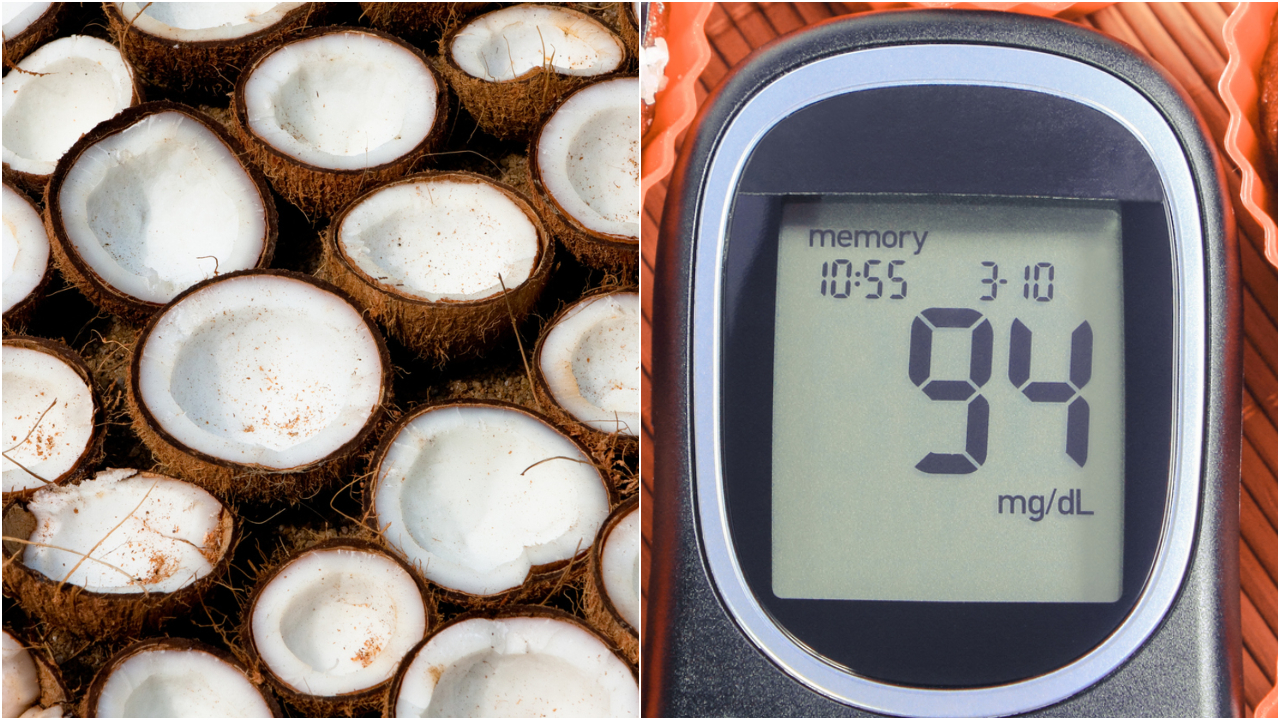White coconut is rich in dietary fiber, MCTs, minerals, and antioxidants, all of which contribute to its diabetes-friendly profile.
Published Oct 10, 2025 | 7:00 AM ⚊ Updated Oct 10, 2025 | 10:26 PM

Representational image. Credit: iStock
Synopsis: White coconut, integral to South Indian cuisine, can be diabetes-friendly when consumed in moderation. Fresh coconut flesh and oil, rich in fiber and MCTs, support blood sugar control and metabolism. Experts caution against processed coconut products and excessive coconut water due to natural sugars. Moderation and dietitian guidance are key for safe inclusion in diabetic diets.
White coconut, from its soft flesh and grated form to its water and oil, is integral to South Indian cuisine, especially in Kerala and Tamil Nadu. Experts say it can be part of a diabetes-friendly diet when consumed in its natural forms and in moderation.
They caution that while fresh coconut can be beneficial, processed or sweetened coconut products should be limited. Moderation, they say, is the key to enjoying coconut’s perks without overdoing it.
According to Thangamani KGT, Head of Nutrition and Dietetics, DMDSC, the various parts of coconut, including its water, oil, and white flesh, interact differently with blood sugar.
“Coconut water has natural sugars and can shoot up the blood sugars immediately. Coconut flesh contains fibre and healthy fats, which can slow glucose absorption and improve post-meal blood sugar control,” she told South First.
Thangamani further notes that coconut oil, while rich in fats, does not raise blood sugar directly. Instead, it can influence insulin sensitivity and also affect cholesterol levels, which is an important consideration for individuals managing diabetes.
This distinction, she says, makes it essential to understand which component of the coconut is being consumed.
The nutritional differences between coconut components highlight the need for awareness among consumers. Thangamani says that while the flesh and oil can be supportive, products made from coconut that are processed or sweetened could have the opposite effect on blood sugar.
By understanding the distinct effects of coconut water, oil, and flesh, diabetes patients can make informed dietary choices, integrating fresh coconut appropriately into their meals without inadvertently raising their glucose levels.
Experts stress that not all coconut products are equally beneficial for diabetics. Thangamani adds, “Fresh coconut flesh is beneficial, as it provides fibre, minerals, and medium-chain triglycerides (MCTs) that support metabolism.”
She contrasts this with processed coconut products, desserts made with coconut, or sweetened coconut milk, which can raise blood sugar and contribute to excessive fat intake, potentially affecting cardiovascular health.
Speaking to South First, Umasakthy G, Registered Dietitian, DMDSC, echoes this caution, particularly regarding coconut oil. While it can be part of a balanced diet, excessive intake may increase saturated fat consumption, and patients need to measure and monitor their usage carefully.
Both experts bank on the importance of fresh and minimally processed coconut. Umasakthy states, “Fresh coconuts are better than processed coconut products,” reiterating the principle that moderation is the key when including coconut in a diabetic diet.
By distinguishing the beneficial parts from the potentially harmful ones, Thangamani and Umasakthy provide a practical framework for diabetics to enjoy the benefits of coconut while minimising risks, highlighting that awareness and portion control are central to safe consumption.
White coconut is rich in dietary fibre, medium-chain triglycerides (MCTs), minerals, and antioxidants, all of which contribute to its diabetes-friendly profile.
Thangamani notes that fibre in the coconut flesh slows glucose absorption, helping to regulate blood sugar levels after meals. Meanwhile, MCTs in coconut oil can assist in improving insulin sensitivity and support weight management.
Umasakthy highlights the importance of minerals such as magnesium and potassium, which contribute to nerve and heart health, both particularly relevant for people with diabetes. Additionally, antioxidants present in coconut help reduce biological stress, complementing its metabolic benefits.
Moderate consumption of coconut, both flesh and oil, can also support healthy lipid metabolism and satiety, making it easier to manage overall calorie intake. However, both experts caution that coconut alone cannot reverse insulin resistance. Instead, it should be incorporated as part of a balanced, diabetes-friendly diet.
Umasakthy clarifies the guidance clearly: “Small portions of coconut can be helpful. Coconut oil is rich in calories. Coconut water has natural sugars. Moderation is the key.”
Underlining the significance of personalised advice, experts encourage people to consult a doctor or dietitian to ensure coconut is consumed safely and appropriately.
(Edited by Amit Vasudev)
